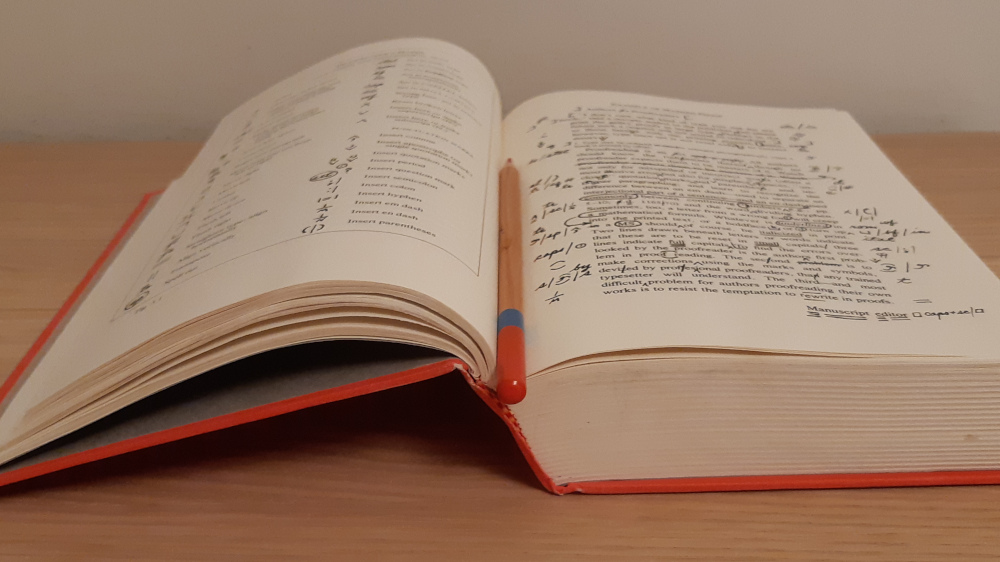By Michael Iaboni
I was fortunate to learn the best practices in proofreading thanks to my excellent teachers at Queen’s University. They were accomplished, long-working editors who had a knack for finding just the right way to bring something from good to great. And because I want to live in a world where editing and proper layout are valued, I want to share some of these tips with you.
1. Familiarize yourself with mark-ups
Although it is likely that you’ll do most proofreading on a computer nowadays, mastering mark-up symbols is crucial. In fact, you will likely be expected to use mark-up symbols when working in Adobe Acrobat. And if you’re working with a paper copy, you’ll definitely need to know these symbols inside and out. Here’s a useful link to a list of mark-ups, their meanings, and how to use them.
2. Don’t rely entirely on spell- and grammar-checkers
While it may be tempting to use spell- and grammar-checkers to save time when you have a desk full of work to do, your own perceptiveness will always be superior. Spell-checkers are useful and can catch egregious spelling errors with ease, but they can often miss small things like the correct use of to and too. Spell-checkers have a limited dictionary, so words that are not in their memory may show up as misspelled. If you use them too much, you won’t be training your editor’s awareness.
3. Focus on the layout
When proofreading, you should focus only on the layout of the page in front of you and not on the stylistic and structural elements of sentences. Yes, people make mistakes and miss things, so correct any obvious errors. But if someone doesn’t place a comma before a conjunction, like you usually do, fight the urge to correct it. Just because someone writes a sentence stylistically differently from you doesn’t mean the sentence is wrong. Always remember that, in the proofreading stage, the structural, stylistic, and copy editing have already been accomplished and signed off on. Your job, now, is to ensure the text and images meet layout standards.
4. Check the margins, ends of paragraphs, and new pages first
A lot of hassle can be avoided if you just go through the margins, ends of paragraphs, and new pages first. Check the margins for waterfalls (three or more consecutive hyphenated lines) and to make sure the first and final lines aren’t hyphenated. Look at the final lines of the paragraphs to make sure there are no widows. And make sure no new page has only a single line. You’ll be surprised how much you’ll catch and correct, especially if you’re proofreading a book.
5. Check for one error at a time
I know I’m asking for a lot here, but if you have extra time, or if the layout is small, it’s worth the investment to check for errors one at a time. If you’re looking solely for orphans, you’re more likely to pick up orphans. If you’re looking solely for waterfalls, you’re more likely to pick up waterfalls. You’ll get a more accurate proofread this way and eventually develop a natural ability to see mistakes the moment you look at a page.
6. Read every word out loud slowly
Reading out loud forces you to say each word and hear how they sound together. If you read silently or in your head, you may unconsciously skip over errors. For instance, in the first sentence of this paragraph I accidentally spelled word as world and didn’t catch it until I went back through this article (spell-check didn’t catch it either, so another point goes to your own awareness over spell- and grammar-checkers). If possible, work from a printed copy so you can follow along with your finger, and make marks where needed.
7. Read backwards
Reading backwards can help find layout errors, especially when comparing the finished layout to the copy deck provided. Your brain won’t latch onto the punctuation, grammar, and content while reading backwards. Instead, you will be more likely to notice discrepancies between the layout and copy deck and even smaller things like abnormal spacing between words. You can start at the absolute end of a document and work your way to the beginning, or you can do it paragraph by paragraph. You can also start reading sentence by sentence if you want practice before you start reading word by word.
Every proofreading assignment you do will be different, and some clients will expect different things. But if you can get these basics rooted, I have no doubt you can succeed in all of your proofreading endeavours.
Michael Iaboni is a freelance writer and editor based in Toronto. He graduated from York University with a degree in English and Creative Writing and then attended Queen’s University, where he obtained a Professional Editing Standards Certificate.
This article was copy edited by Paul Neuviale.


Hmmm, haven’t heard of “waterfalls” before. Tried googling it and got nothing. Can you explain what this means? Interesting article.
LikeLike
Thanks! I guess waterfalls do have some other names they go by too. I think ladders is more common, but for whatever reason the circle I run in calls it waterfalls and that’s what I went with. Basically, it’s a rare phenomenon where three consecutive lines in a row are hyphenated. It doesn’t really look good, so I try to catch and correct them wherever I can
LikeLike